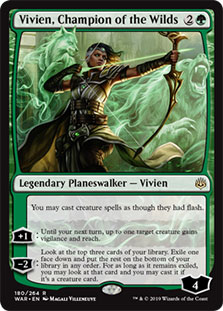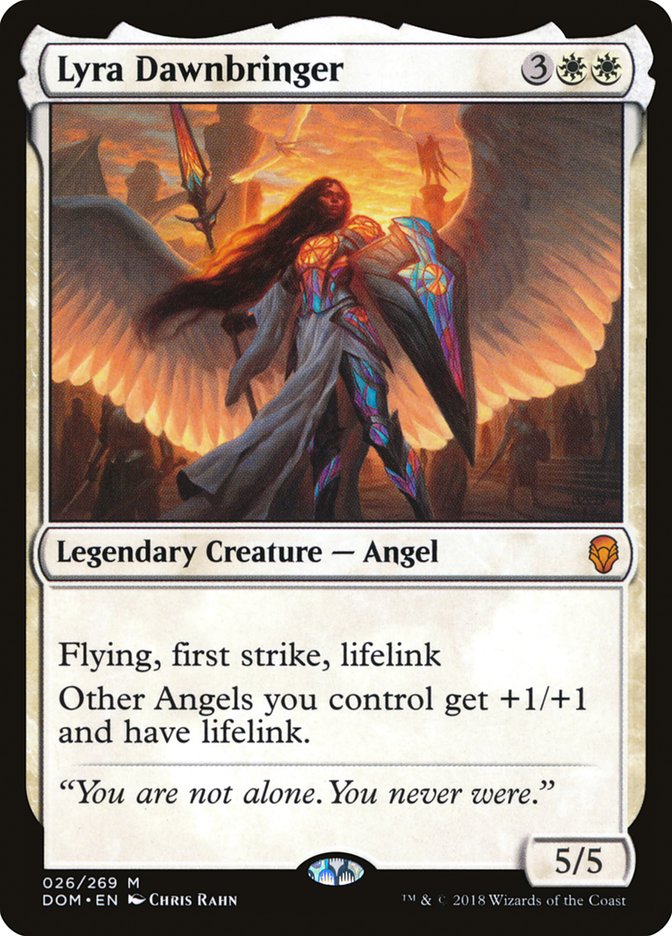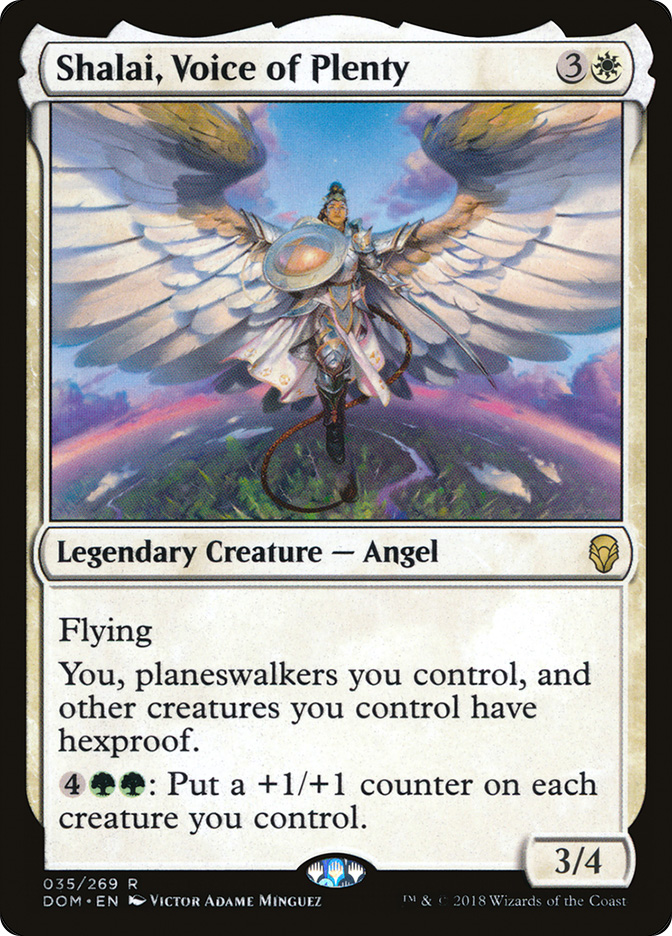War of the Spark preview season rages on, and there is no shortage of incredible-looking cards looming on the horizons of Standard. The one previewed card that excites me the most is Vivien, Champion of the Wilds. While I don’t believe this new planeswalker will be as dominating as its five-mana counterpart, I think there is real potential for it to be a card you’ll play against early and often.
When inspecting any of the new planeswalkers, the natural place to begin evaluation is by looking at their static ability. Viven shines here, as the ability to grant all of your creatures flash will likely make it one of the most difficult cards to navigate around in all of Standard. This ability seems to have relevance against every existing strategy that I can think of. From giving you the ability to maneuver around sweepers to ambushing creatures that dare to get into the red zone against your open mana, Vivien on a battlefield with untapped mana is a scary thing to face down.
The first place my mind went after looking at this ability is how can we maximize the potential to blow out unsuspecting opponents. The card that I most see as being a nightmare when cast at instant speed is Lyra Dawnbringer, who was actually employed in a very similar manner in an Azorius Flash deck shortly after Dominaria was released. There’s palpable tension that occurs when you force your opponent to either attack with a single creature and get destroyed by the first-striking Angel or send their team into a Settle the Wreckage, and this was the main point of strength for the short-lived archetype.
The next card that seems like an almost effortless pairing with the core of Lyra and Vivien is Shalai, Voice of Plenty.
Generally speaking, Vivien will be able to make any creature with a spell-like ability much better by greatly increasing the flexibility in which you can deploy them. Kraul Harpooner can wreak havoc after Mono-Blue Aggro has attacked with their small fliers, Knight of Autumn can jump into the fray to destroy a fresh Wilderness Reclamation before it gets even a single untap, and Growth-Chamber Guardian can be given new windows to leap onto the battlefield and adapt while the opponent is tapped out.
Moving on to the +1 ability, we find what is very likely the highest-variance aspect of the new planeswalker. Vigilance and reach will sometimes be irrelevant abilities when you’re up against Esper Control or Simic Nexus, but that won’t always be the case. When playing creature mirrors, the addition of vigilance onto your most powerful creature can make racing exceptionally difficult, especially in conjunction with the ability to leave your mana up thanks to Vivien’s static ability.
While I’d expect the reach aspect to be a little less valuable, it will also have its moments. Mono-Blue Aggro is a deck built around abusing the lack of flying in current Standard and there are a few other impact flyers lurking around the peripheries of the format. Ultimately, the +1 is not the ability that draws you to play Vivien, but I believe it has enough utility to avoid being prohibitively bad.
Vivien’s final ability is the card advantage-accruing -2. The first and most obvious aspect is how this demands you play a large number of creatures to avoid whiffing, but I don’t look at this as much of a cost. While it’s more subtle, the static ability was already pushing you in the direction of loading up on creatures. Looking at some previous work from Frank Karsten, playing a deck with 26 creatures should let you hit 83.26% of the time, and while this is reasonably consistent, I’d err on the side of playing too many creatures rather than too few.
One aspect of this ability that I like is how Vivien’s play pattern will make it hard for redundant copies to get stuck in your hand. With four starting loyalty on Vivien, it’s relatively painless to downtick twice before deploying your backup copy. This type of fluid gameplay encourages you to play the maximum amount of copies and really lean in to making Vivien one of the centerpieces of your strategy.
Having the card advantage tied to a minus ability does hamstring the ability for Vivien to run away with the game by itself. Should you not have a backup copy and want to keep your planeswalker around for a third downtick, you’ll need to keep her on the battlefield for a total of five turns. This type of delay on returns means that Viven does not let you keep up with the premier card advantage engines of Standard like most existing planeswalkers and Search for Azcanta, so you’ll need to press the advantage that the flash ability gives you to close the game quickly against more powerful midrange decks.
With all these potential applications in mind, here’s my first draft for a Selesnya shell that tries to maximize the power of Vivien.
Creatures (27)
- 4 Llanowar Elves
- 4 Wildgrowth Walker
- 4 Merfolk Branchwalker
- 4 Jadelight Ranger
- 3 Lyra Dawnbringer
- 3 Shalai, Voice of Plenty
- 4 Resplendent Angel
- 1 Trostani Discordant
Planeswalkers (4)
Lands (23)
Spells (6)
Sideboard

While we’ve spent a lot of time looking at the particulars of all the abilities at play on the new Vivien, it’s important to view these abilities through the lens of how much you have to invest to gain access to them. As a three-mana planeswalker that shares a color with Llanowar Elves, the amount of power required to see play is significantly lowered. While you don’t have the powerful inevitability that an ultimate provides, combining flash with modest card advantage and combat-altering stats forms a card that I think we’ll see plenty of in the years to come.




